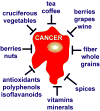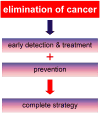Cancer prevention research - then and now
- PMID: 19536108
- PMCID: PMC2838238
- DOI: 10.1038/nrc2646
Cancer prevention research - then and now
Abstract
Throughout history, humankind has won the battle against deadly diseases, including small pox and polio, by defeating them through prevention. Cancer prevention is a global priority, but studying history suggests that the journey towards achieving this goal is difficult and full of detours and roadblocks. Epidemiology and clinical evidence clearly indicate that specific genetic, environmental and behavioural factors are associated with an increased risk for cancer development. What can we learn from the past that is applicable to the reality of successful cancer prevention?
Figures



References
-
- Danaei G, Vander Hoorn S, Lopez AD, Murray CJ, Ezzati M. Causes of cancer in the world: comparative risk assessment of nine behavioural and environmental risk factors. Lancet. 2005;366:1784–93. - PubMed
-
- Gurunluoglu R, Gurunluoglu A. Paul of Aegina: landmark in surgical progress. World J Surg. 2003;27:18–25. - PubMed
-
- Ramazzini B. In: De Morbis Artificium Diatriba. Wright WC, translator. University of Chicago Press; Chicago, IL: 1940.
-
- Hill J. In: Cautions against the immoderate use of snuff. Baldwin R, Jackson J, editors. London: 1761.
-
- Pott P. Chirurgical observations relative to the cataract, the polypus of the nose, the cancer of the scrotum, the different kinds of ruptures and the mortifications of the toes and feet. Haves, Clarke and Collins; London: 1775.
Publication types
MeSH terms
Substances
Grants and funding
LinkOut - more resources
Full Text Sources
Other Literature Sources
Miscellaneous

